Comprehensive Analysis of the Global Financial Crisis: Report
VerifiedAdded on 2020/04/15
|11
|2702
|248
Report
AI Summary
This report examines the global financial crisis, beginning with its origins in the subprime mortgage market and the credit crunch of 2007. It delves into the causes, including the failure of rating agencies and rising food and petrol prices. The report analyzes the spread of the crisis globally, the responses of various countries, and the role of the US Federal Reserve. It further explores the Reserve Bank of Australia's actions, such as interest rate cuts, to combat the crisis and their effects on the Australian economy. Finally, the report discusses the Sino-Australian relationship, highlighting how China's economic performance influenced Australia during and after the crisis, including trade and investment impacts, and the role of the Sino-Australia free-trade agreement.

Running head: ASSIGNMENT OF GLOBAL FINANCIAL CRISIS
Assignment of Global Financial Crisis
Name of the Student
Name of the University
Author Note
Assignment of Global Financial Crisis
Name of the Student
Name of the University
Author Note
Paraphrase This Document
Need a fresh take? Get an instant paraphrase of this document with our AI Paraphraser

1ASSIGNMENT OF GLOBAL FINANCIAL CRISIS
Contents
1. Answer...................................................................................................................................2
2. Answer...................................................................................................................................3
6. Answer...................................................................................................................................5
Reference:..................................................................................................................................9
Contents
1. Answer...................................................................................................................................2
2. Answer...................................................................................................................................3
6. Answer...................................................................................................................................5
Reference:..................................................................................................................................9
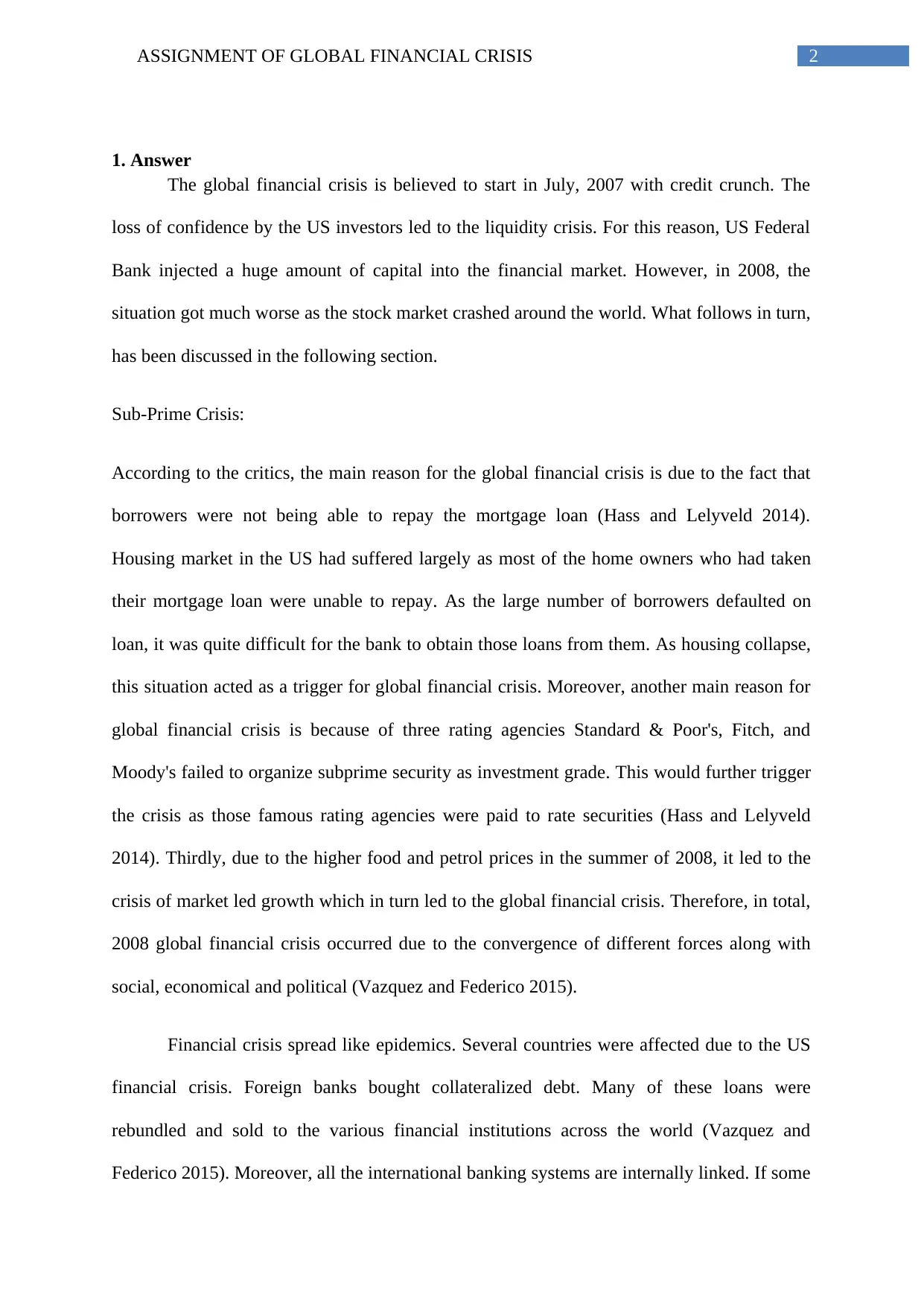
2ASSIGNMENT OF GLOBAL FINANCIAL CRISIS
1. Answer
The global financial crisis is believed to start in July, 2007 with credit crunch. The
loss of confidence by the US investors led to the liquidity crisis. For this reason, US Federal
Bank injected a huge amount of capital into the financial market. However, in 2008, the
situation got much worse as the stock market crashed around the world. What follows in turn,
has been discussed in the following section.
Sub-Prime Crisis:
According to the critics, the main reason for the global financial crisis is due to the fact that
borrowers were not being able to repay the mortgage loan (Hass and Lelyveld 2014).
Housing market in the US had suffered largely as most of the home owners who had taken
their mortgage loan were unable to repay. As the large number of borrowers defaulted on
loan, it was quite difficult for the bank to obtain those loans from them. As housing collapse,
this situation acted as a trigger for global financial crisis. Moreover, another main reason for
global financial crisis is because of three rating agencies Standard & Poor's, Fitch, and
Moody's failed to organize subprime security as investment grade. This would further trigger
the crisis as those famous rating agencies were paid to rate securities (Hass and Lelyveld
2014). Thirdly, due to the higher food and petrol prices in the summer of 2008, it led to the
crisis of market led growth which in turn led to the global financial crisis. Therefore, in total,
2008 global financial crisis occurred due to the convergence of different forces along with
social, economical and political (Vazquez and Federico 2015).
Financial crisis spread like epidemics. Several countries were affected due to the US
financial crisis. Foreign banks bought collateralized debt. Many of these loans were
rebundled and sold to the various financial institutions across the world (Vazquez and
Federico 2015). Moreover, all the international banking systems are internally linked. If some
1. Answer
The global financial crisis is believed to start in July, 2007 with credit crunch. The
loss of confidence by the US investors led to the liquidity crisis. For this reason, US Federal
Bank injected a huge amount of capital into the financial market. However, in 2008, the
situation got much worse as the stock market crashed around the world. What follows in turn,
has been discussed in the following section.
Sub-Prime Crisis:
According to the critics, the main reason for the global financial crisis is due to the fact that
borrowers were not being able to repay the mortgage loan (Hass and Lelyveld 2014).
Housing market in the US had suffered largely as most of the home owners who had taken
their mortgage loan were unable to repay. As the large number of borrowers defaulted on
loan, it was quite difficult for the bank to obtain those loans from them. As housing collapse,
this situation acted as a trigger for global financial crisis. Moreover, another main reason for
global financial crisis is because of three rating agencies Standard & Poor's, Fitch, and
Moody's failed to organize subprime security as investment grade. This would further trigger
the crisis as those famous rating agencies were paid to rate securities (Hass and Lelyveld
2014). Thirdly, due to the higher food and petrol prices in the summer of 2008, it led to the
crisis of market led growth which in turn led to the global financial crisis. Therefore, in total,
2008 global financial crisis occurred due to the convergence of different forces along with
social, economical and political (Vazquez and Federico 2015).
Financial crisis spread like epidemics. Several countries were affected due to the US
financial crisis. Foreign banks bought collateralized debt. Many of these loans were
rebundled and sold to the various financial institutions across the world (Vazquez and
Federico 2015). Moreover, all the international banking systems are internally linked. If some
⊘ This is a preview!⊘
Do you want full access?
Subscribe today to unlock all pages.

Trusted by 1+ million students worldwide
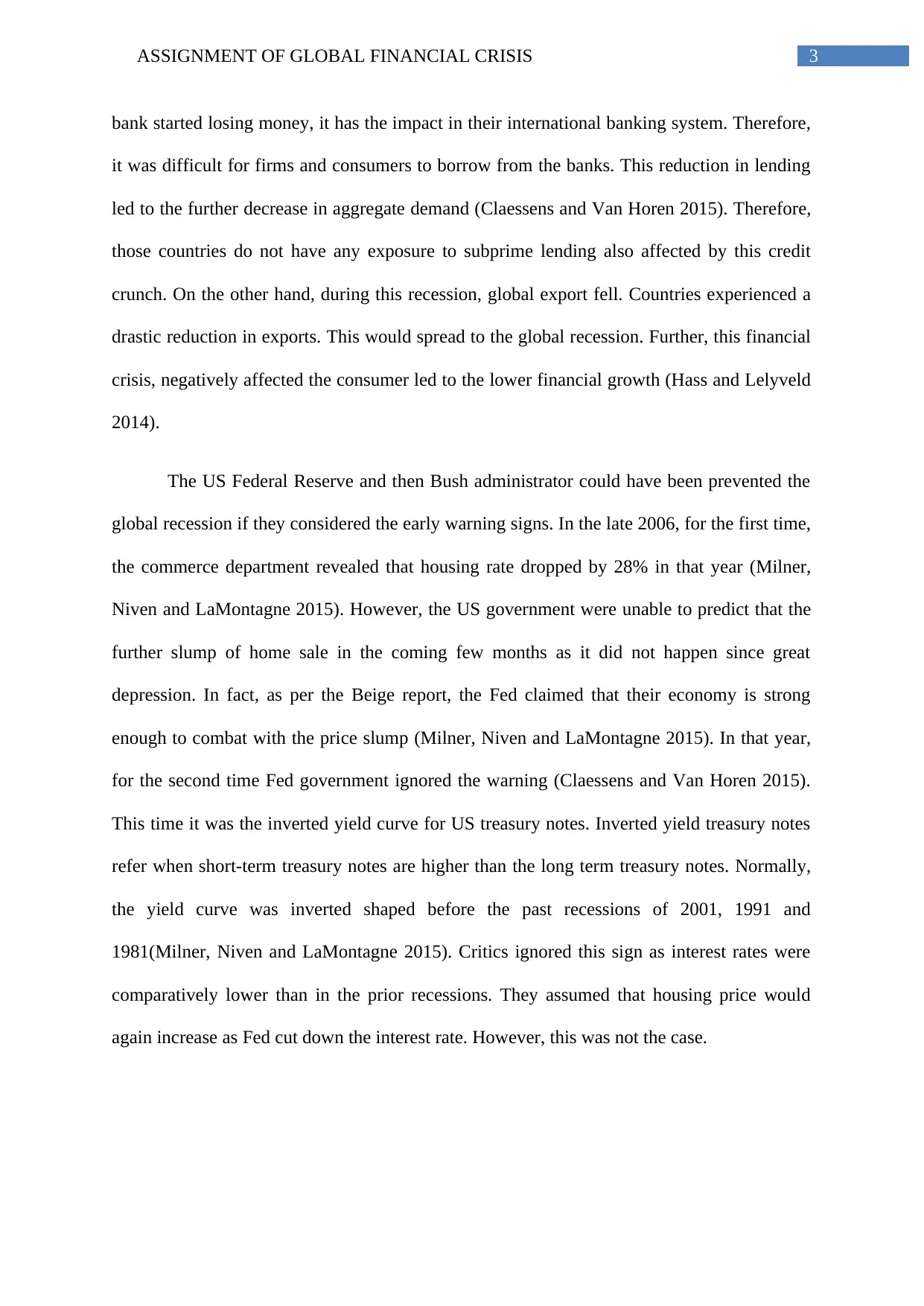
3ASSIGNMENT OF GLOBAL FINANCIAL CRISIS
bank started losing money, it has the impact in their international banking system. Therefore,
it was difficult for firms and consumers to borrow from the banks. This reduction in lending
led to the further decrease in aggregate demand (Claessens and Van Horen 2015). Therefore,
those countries do not have any exposure to subprime lending also affected by this credit
crunch. On the other hand, during this recession, global export fell. Countries experienced a
drastic reduction in exports. This would spread to the global recession. Further, this financial
crisis, negatively affected the consumer led to the lower financial growth (Hass and Lelyveld
2014).
The US Federal Reserve and then Bush administrator could have been prevented the
global recession if they considered the early warning signs. In the late 2006, for the first time,
the commerce department revealed that housing rate dropped by 28% in that year (Milner,
Niven and LaMontagne 2015). However, the US government were unable to predict that the
further slump of home sale in the coming few months as it did not happen since great
depression. In fact, as per the Beige report, the Fed claimed that their economy is strong
enough to combat with the price slump (Milner, Niven and LaMontagne 2015). In that year,
for the second time Fed government ignored the warning (Claessens and Van Horen 2015).
This time it was the inverted yield curve for US treasury notes. Inverted yield treasury notes
refer when short-term treasury notes are higher than the long term treasury notes. Normally,
the yield curve was inverted shaped before the past recessions of 2001, 1991 and
1981(Milner, Niven and LaMontagne 2015). Critics ignored this sign as interest rates were
comparatively lower than in the prior recessions. They assumed that housing price would
again increase as Fed cut down the interest rate. However, this was not the case.
bank started losing money, it has the impact in their international banking system. Therefore,
it was difficult for firms and consumers to borrow from the banks. This reduction in lending
led to the further decrease in aggregate demand (Claessens and Van Horen 2015). Therefore,
those countries do not have any exposure to subprime lending also affected by this credit
crunch. On the other hand, during this recession, global export fell. Countries experienced a
drastic reduction in exports. This would spread to the global recession. Further, this financial
crisis, negatively affected the consumer led to the lower financial growth (Hass and Lelyveld
2014).
The US Federal Reserve and then Bush administrator could have been prevented the
global recession if they considered the early warning signs. In the late 2006, for the first time,
the commerce department revealed that housing rate dropped by 28% in that year (Milner,
Niven and LaMontagne 2015). However, the US government were unable to predict that the
further slump of home sale in the coming few months as it did not happen since great
depression. In fact, as per the Beige report, the Fed claimed that their economy is strong
enough to combat with the price slump (Milner, Niven and LaMontagne 2015). In that year,
for the second time Fed government ignored the warning (Claessens and Van Horen 2015).
This time it was the inverted yield curve for US treasury notes. Inverted yield treasury notes
refer when short-term treasury notes are higher than the long term treasury notes. Normally,
the yield curve was inverted shaped before the past recessions of 2001, 1991 and
1981(Milner, Niven and LaMontagne 2015). Critics ignored this sign as interest rates were
comparatively lower than in the prior recessions. They assumed that housing price would
again increase as Fed cut down the interest rate. However, this was not the case.
Paraphrase This Document
Need a fresh take? Get an instant paraphrase of this document with our AI Paraphraser
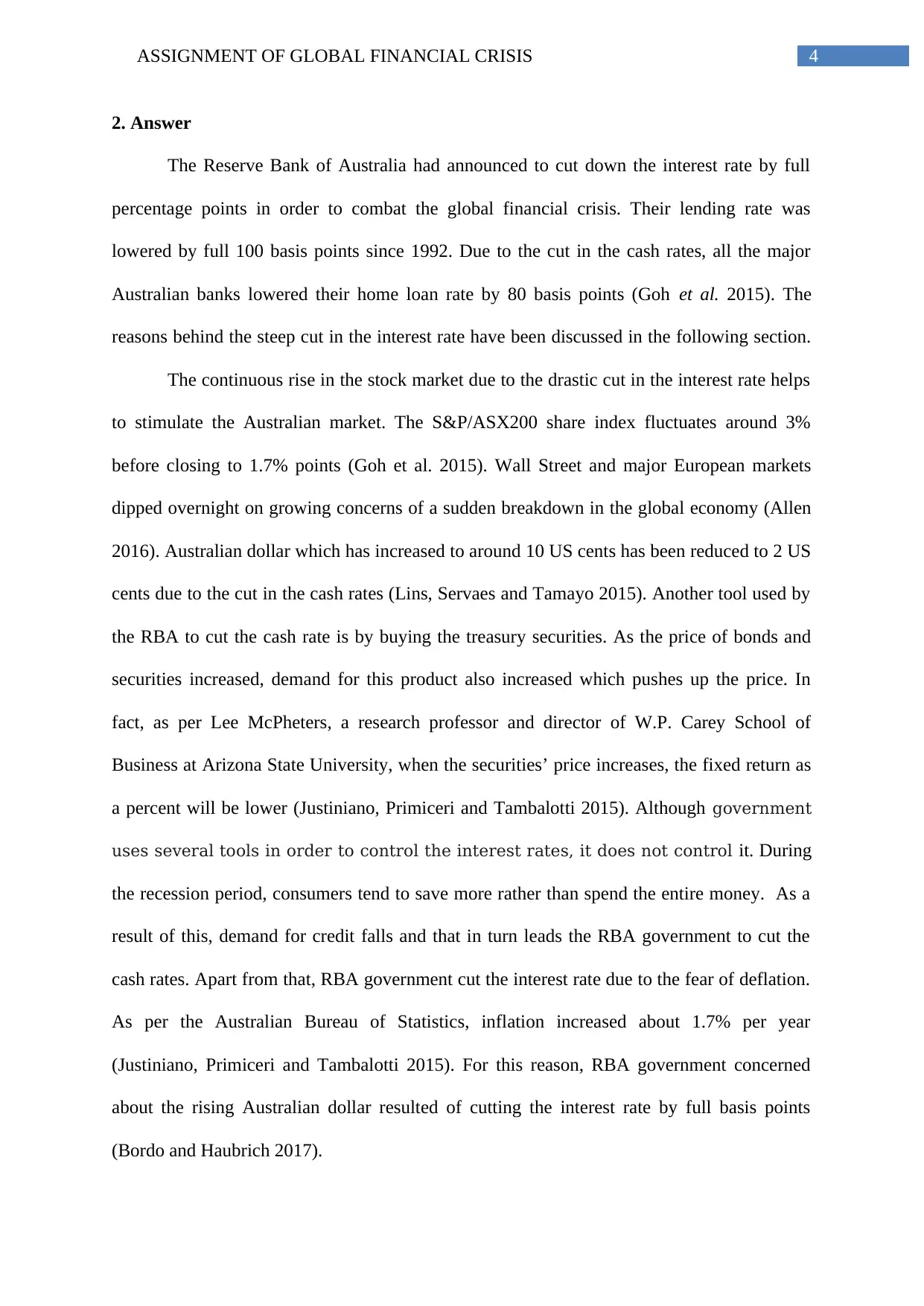
4ASSIGNMENT OF GLOBAL FINANCIAL CRISIS
2. Answer
The Reserve Bank of Australia had announced to cut down the interest rate by full
percentage points in order to combat the global financial crisis. Their lending rate was
lowered by full 100 basis points since 1992. Due to the cut in the cash rates, all the major
Australian banks lowered their home loan rate by 80 basis points (Goh et al. 2015). The
reasons behind the steep cut in the interest rate have been discussed in the following section.
The continuous rise in the stock market due to the drastic cut in the interest rate helps
to stimulate the Australian market. The S&P/ASX200 share index fluctuates around 3%
before closing to 1.7% points (Goh et al. 2015). Wall Street and major European markets
dipped overnight on growing concerns of a sudden breakdown in the global economy (Allen
2016). Australian dollar which has increased to around 10 US cents has been reduced to 2 US
cents due to the cut in the cash rates (Lins, Servaes and Tamayo 2015). Another tool used by
the RBA to cut the cash rate is by buying the treasury securities. As the price of bonds and
securities increased, demand for this product also increased which pushes up the price. In
fact, as per Lee McPheters, a research professor and director of W.P. Carey School of
Business at Arizona State University, when the securities’ price increases, the fixed return as
a percent will be lower (Justiniano, Primiceri and Tambalotti 2015). Although government
uses several tools in order to control the interest rates, it does not control it. During
the recession period, consumers tend to save more rather than spend the entire money. As a
result of this, demand for credit falls and that in turn leads the RBA government to cut the
cash rates. Apart from that, RBA government cut the interest rate due to the fear of deflation.
As per the Australian Bureau of Statistics, inflation increased about 1.7% per year
(Justiniano, Primiceri and Tambalotti 2015). For this reason, RBA government concerned
about the rising Australian dollar resulted of cutting the interest rate by full basis points
(Bordo and Haubrich 2017).
2. Answer
The Reserve Bank of Australia had announced to cut down the interest rate by full
percentage points in order to combat the global financial crisis. Their lending rate was
lowered by full 100 basis points since 1992. Due to the cut in the cash rates, all the major
Australian banks lowered their home loan rate by 80 basis points (Goh et al. 2015). The
reasons behind the steep cut in the interest rate have been discussed in the following section.
The continuous rise in the stock market due to the drastic cut in the interest rate helps
to stimulate the Australian market. The S&P/ASX200 share index fluctuates around 3%
before closing to 1.7% points (Goh et al. 2015). Wall Street and major European markets
dipped overnight on growing concerns of a sudden breakdown in the global economy (Allen
2016). Australian dollar which has increased to around 10 US cents has been reduced to 2 US
cents due to the cut in the cash rates (Lins, Servaes and Tamayo 2015). Another tool used by
the RBA to cut the cash rate is by buying the treasury securities. As the price of bonds and
securities increased, demand for this product also increased which pushes up the price. In
fact, as per Lee McPheters, a research professor and director of W.P. Carey School of
Business at Arizona State University, when the securities’ price increases, the fixed return as
a percent will be lower (Justiniano, Primiceri and Tambalotti 2015). Although government
uses several tools in order to control the interest rates, it does not control it. During
the recession period, consumers tend to save more rather than spend the entire money. As a
result of this, demand for credit falls and that in turn leads the RBA government to cut the
cash rates. Apart from that, RBA government cut the interest rate due to the fear of deflation.
As per the Australian Bureau of Statistics, inflation increased about 1.7% per year
(Justiniano, Primiceri and Tambalotti 2015). For this reason, RBA government concerned
about the rising Australian dollar resulted of cutting the interest rate by full basis points
(Bordo and Haubrich 2017).
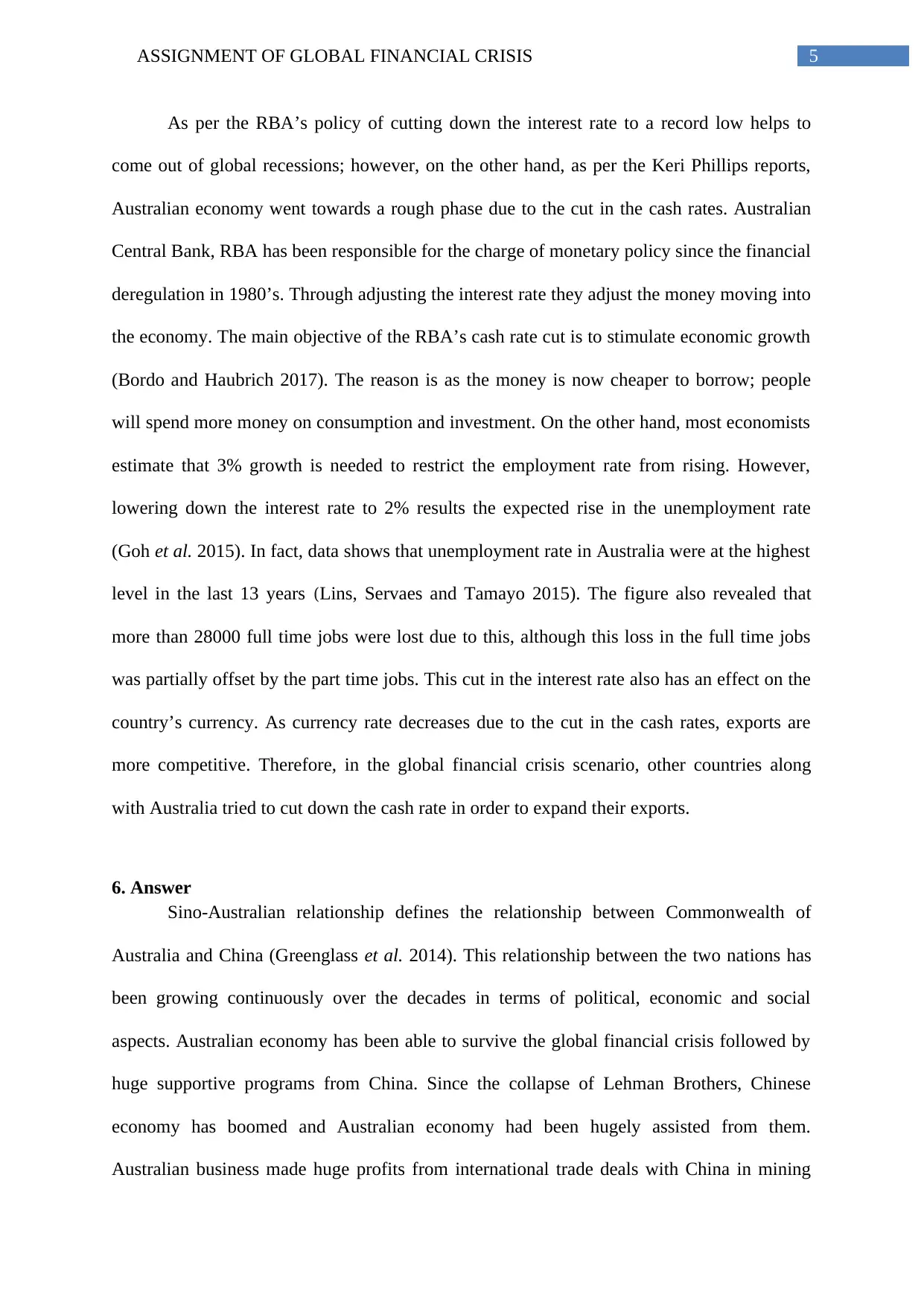
5ASSIGNMENT OF GLOBAL FINANCIAL CRISIS
As per the RBA’s policy of cutting down the interest rate to a record low helps to
come out of global recessions; however, on the other hand, as per the Keri Phillips reports,
Australian economy went towards a rough phase due to the cut in the cash rates. Australian
Central Bank, RBA has been responsible for the charge of monetary policy since the financial
deregulation in 1980’s. Through adjusting the interest rate they adjust the money moving into
the economy. The main objective of the RBA’s cash rate cut is to stimulate economic growth
(Bordo and Haubrich 2017). The reason is as the money is now cheaper to borrow; people
will spend more money on consumption and investment. On the other hand, most economists
estimate that 3% growth is needed to restrict the employment rate from rising. However,
lowering down the interest rate to 2% results the expected rise in the unemployment rate
(Goh et al. 2015). In fact, data shows that unemployment rate in Australia were at the highest
level in the last 13 years (Lins, Servaes and Tamayo 2015). The figure also revealed that
more than 28000 full time jobs were lost due to this, although this loss in the full time jobs
was partially offset by the part time jobs. This cut in the interest rate also has an effect on the
country’s currency. As currency rate decreases due to the cut in the cash rates, exports are
more competitive. Therefore, in the global financial crisis scenario, other countries along
with Australia tried to cut down the cash rate in order to expand their exports.
6. Answer
Sino-Australian relationship defines the relationship between Commonwealth of
Australia and China (Greenglass et al. 2014). This relationship between the two nations has
been growing continuously over the decades in terms of political, economic and social
aspects. Australian economy has been able to survive the global financial crisis followed by
huge supportive programs from China. Since the collapse of Lehman Brothers, Chinese
economy has boomed and Australian economy had been hugely assisted from them.
Australian business made huge profits from international trade deals with China in mining
As per the RBA’s policy of cutting down the interest rate to a record low helps to
come out of global recessions; however, on the other hand, as per the Keri Phillips reports,
Australian economy went towards a rough phase due to the cut in the cash rates. Australian
Central Bank, RBA has been responsible for the charge of monetary policy since the financial
deregulation in 1980’s. Through adjusting the interest rate they adjust the money moving into
the economy. The main objective of the RBA’s cash rate cut is to stimulate economic growth
(Bordo and Haubrich 2017). The reason is as the money is now cheaper to borrow; people
will spend more money on consumption and investment. On the other hand, most economists
estimate that 3% growth is needed to restrict the employment rate from rising. However,
lowering down the interest rate to 2% results the expected rise in the unemployment rate
(Goh et al. 2015). In fact, data shows that unemployment rate in Australia were at the highest
level in the last 13 years (Lins, Servaes and Tamayo 2015). The figure also revealed that
more than 28000 full time jobs were lost due to this, although this loss in the full time jobs
was partially offset by the part time jobs. This cut in the interest rate also has an effect on the
country’s currency. As currency rate decreases due to the cut in the cash rates, exports are
more competitive. Therefore, in the global financial crisis scenario, other countries along
with Australia tried to cut down the cash rate in order to expand their exports.
6. Answer
Sino-Australian relationship defines the relationship between Commonwealth of
Australia and China (Greenglass et al. 2014). This relationship between the two nations has
been growing continuously over the decades in terms of political, economic and social
aspects. Australian economy has been able to survive the global financial crisis followed by
huge supportive programs from China. Since the collapse of Lehman Brothers, Chinese
economy has boomed and Australian economy had been hugely assisted from them.
Australian business made huge profits from international trade deals with China in mining
⊘ This is a preview!⊘
Do you want full access?
Subscribe today to unlock all pages.

Trusted by 1+ million students worldwide
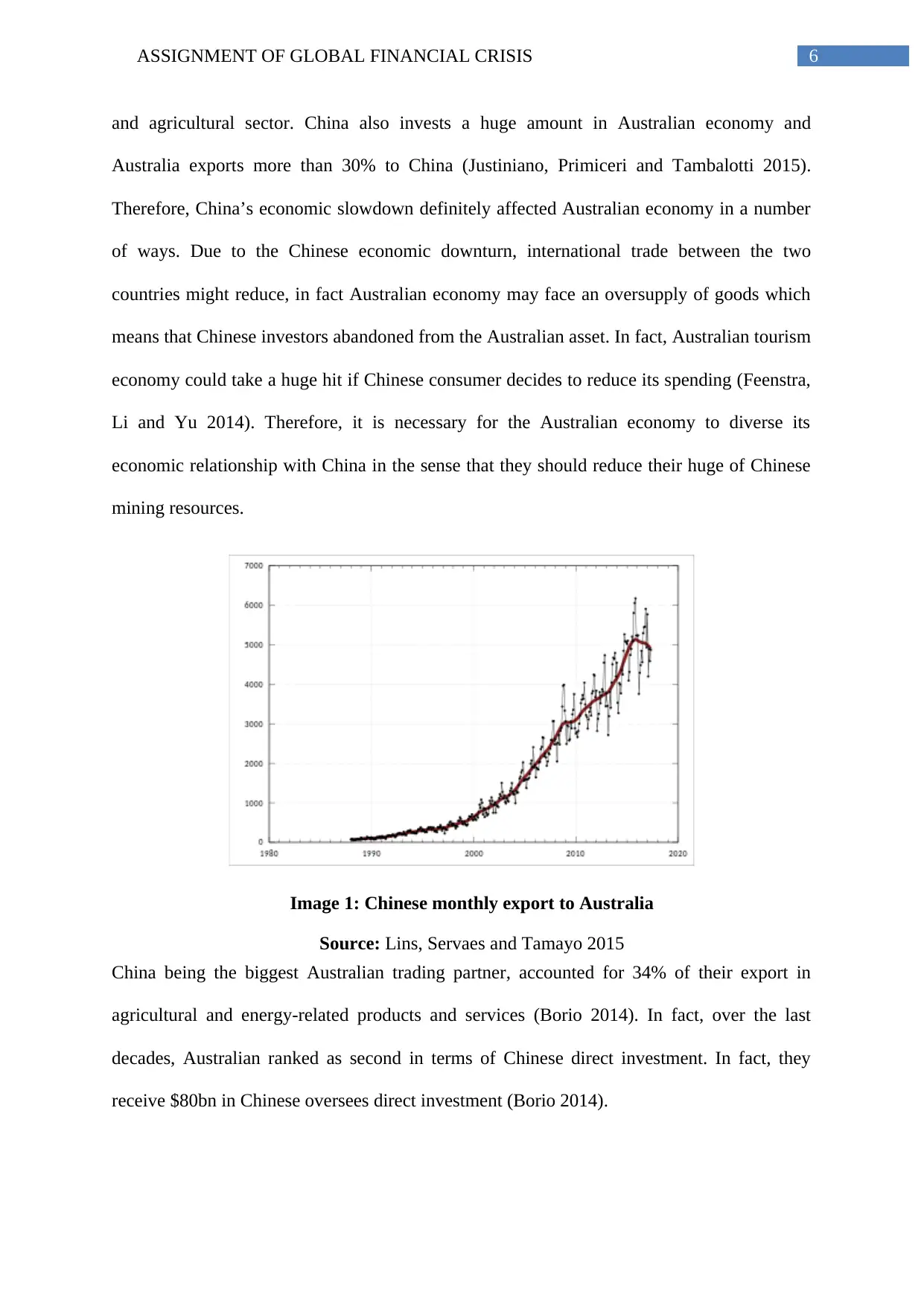
6ASSIGNMENT OF GLOBAL FINANCIAL CRISIS
and agricultural sector. China also invests a huge amount in Australian economy and
Australia exports more than 30% to China (Justiniano, Primiceri and Tambalotti 2015).
Therefore, China’s economic slowdown definitely affected Australian economy in a number
of ways. Due to the Chinese economic downturn, international trade between the two
countries might reduce, in fact Australian economy may face an oversupply of goods which
means that Chinese investors abandoned from the Australian asset. In fact, Australian tourism
economy could take a huge hit if Chinese consumer decides to reduce its spending (Feenstra,
Li and Yu 2014). Therefore, it is necessary for the Australian economy to diverse its
economic relationship with China in the sense that they should reduce their huge of Chinese
mining resources.
China being the biggest Australian trading partner, accounted for 34% of their export in
agricultural and energy-related products and services (Borio 2014). In fact, over the last
decades, Australian ranked as second in terms of Chinese direct investment. In fact, they
receive $80bn in Chinese oversees direct investment (Borio 2014).
Image 1: Chinese monthly export to Australia
Source: Lins, Servaes and Tamayo 2015
and agricultural sector. China also invests a huge amount in Australian economy and
Australia exports more than 30% to China (Justiniano, Primiceri and Tambalotti 2015).
Therefore, China’s economic slowdown definitely affected Australian economy in a number
of ways. Due to the Chinese economic downturn, international trade between the two
countries might reduce, in fact Australian economy may face an oversupply of goods which
means that Chinese investors abandoned from the Australian asset. In fact, Australian tourism
economy could take a huge hit if Chinese consumer decides to reduce its spending (Feenstra,
Li and Yu 2014). Therefore, it is necessary for the Australian economy to diverse its
economic relationship with China in the sense that they should reduce their huge of Chinese
mining resources.
China being the biggest Australian trading partner, accounted for 34% of their export in
agricultural and energy-related products and services (Borio 2014). In fact, over the last
decades, Australian ranked as second in terms of Chinese direct investment. In fact, they
receive $80bn in Chinese oversees direct investment (Borio 2014).
Image 1: Chinese monthly export to Australia
Source: Lins, Servaes and Tamayo 2015
Paraphrase This Document
Need a fresh take? Get an instant paraphrase of this document with our AI Paraphraser
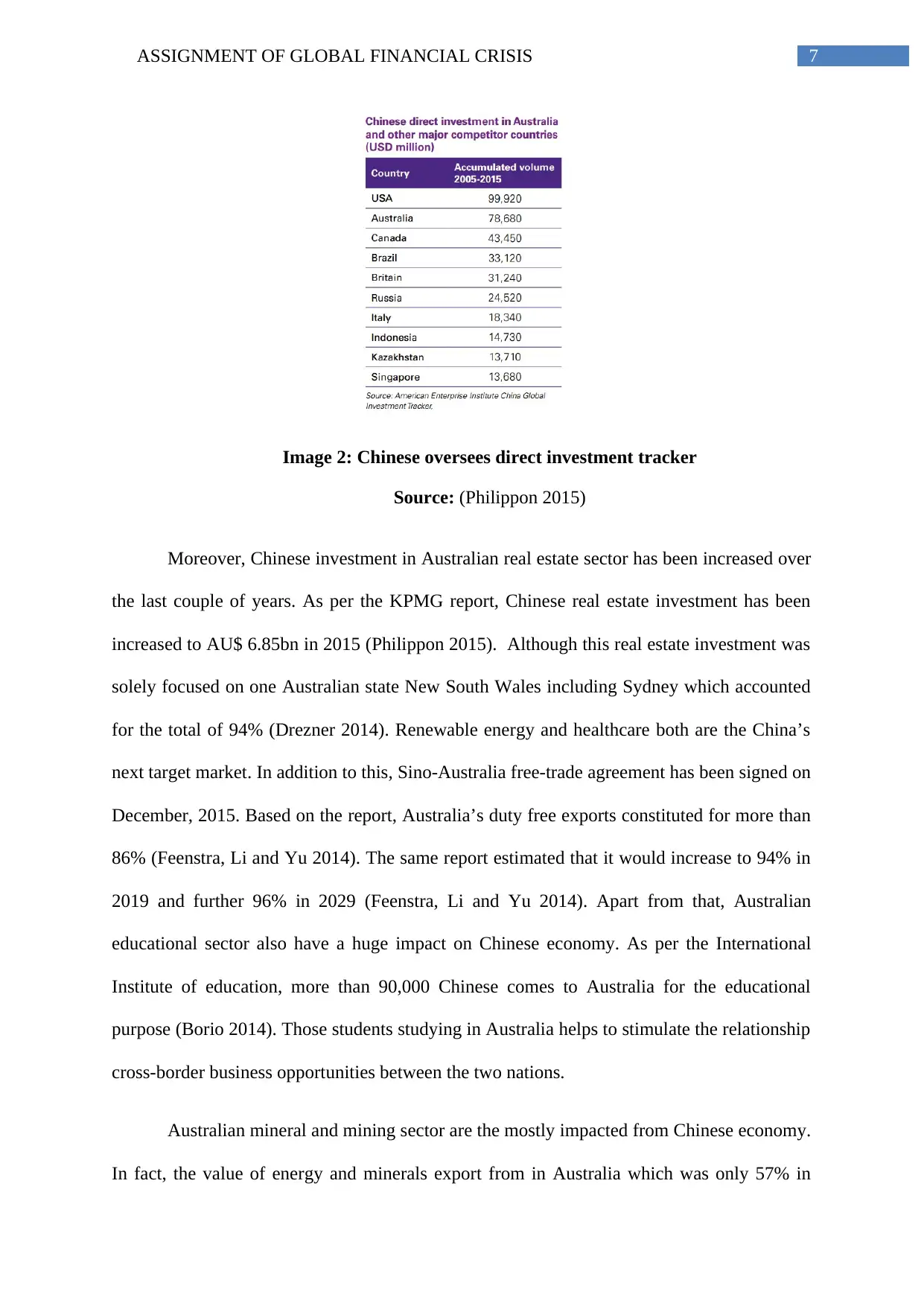
7ASSIGNMENT OF GLOBAL FINANCIAL CRISIS
Moreover, Chinese investment in Australian real estate sector has been increased over
the last couple of years. As per the KPMG report, Chinese real estate investment has been
increased to AU$ 6.85bn in 2015 (Philippon 2015). Although this real estate investment was
solely focused on one Australian state New South Wales including Sydney which accounted
for the total of 94% (Drezner 2014). Renewable energy and healthcare both are the China’s
next target market. In addition to this, Sino-Australia free-trade agreement has been signed on
December, 2015. Based on the report, Australia’s duty free exports constituted for more than
86% (Feenstra, Li and Yu 2014). The same report estimated that it would increase to 94% in
2019 and further 96% in 2029 (Feenstra, Li and Yu 2014). Apart from that, Australian
educational sector also have a huge impact on Chinese economy. As per the International
Institute of education, more than 90,000 Chinese comes to Australia for the educational
purpose (Borio 2014). Those students studying in Australia helps to stimulate the relationship
cross-border business opportunities between the two nations.
Australian mineral and mining sector are the mostly impacted from Chinese economy.
In fact, the value of energy and minerals export from in Australia which was only 57% in
Image 2: Chinese oversees direct investment tracker
Source: (Philippon 2015)
Moreover, Chinese investment in Australian real estate sector has been increased over
the last couple of years. As per the KPMG report, Chinese real estate investment has been
increased to AU$ 6.85bn in 2015 (Philippon 2015). Although this real estate investment was
solely focused on one Australian state New South Wales including Sydney which accounted
for the total of 94% (Drezner 2014). Renewable energy and healthcare both are the China’s
next target market. In addition to this, Sino-Australia free-trade agreement has been signed on
December, 2015. Based on the report, Australia’s duty free exports constituted for more than
86% (Feenstra, Li and Yu 2014). The same report estimated that it would increase to 94% in
2019 and further 96% in 2029 (Feenstra, Li and Yu 2014). Apart from that, Australian
educational sector also have a huge impact on Chinese economy. As per the International
Institute of education, more than 90,000 Chinese comes to Australia for the educational
purpose (Borio 2014). Those students studying in Australia helps to stimulate the relationship
cross-border business opportunities between the two nations.
Australian mineral and mining sector are the mostly impacted from Chinese economy.
In fact, the value of energy and minerals export from in Australia which was only 57% in
Image 2: Chinese oversees direct investment tracker
Source: (Philippon 2015)
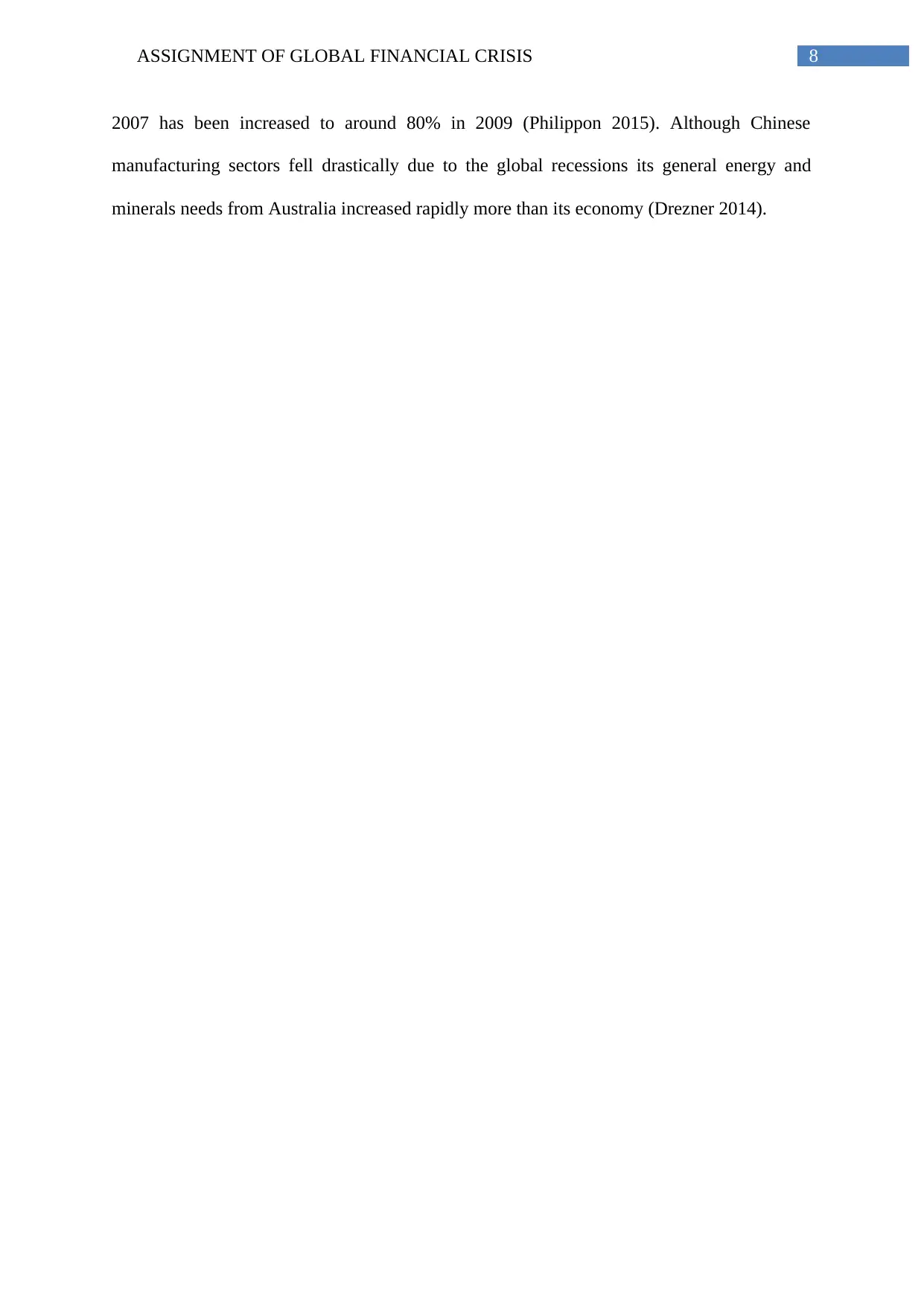
8ASSIGNMENT OF GLOBAL FINANCIAL CRISIS
2007 has been increased to around 80% in 2009 (Philippon 2015). Although Chinese
manufacturing sectors fell drastically due to the global recessions its general energy and
minerals needs from Australia increased rapidly more than its economy (Drezner 2014).
2007 has been increased to around 80% in 2009 (Philippon 2015). Although Chinese
manufacturing sectors fell drastically due to the global recessions its general energy and
minerals needs from Australia increased rapidly more than its economy (Drezner 2014).
⊘ This is a preview!⊘
Do you want full access?
Subscribe today to unlock all pages.

Trusted by 1+ million students worldwide

9ASSIGNMENT OF GLOBAL FINANCIAL CRISIS
Reference:
Allen, R.E., 2016. Financial crises and recession in the global economy. Edward Elgar
Publishing.
Baker, S.R., Bloom, N. and Davis, S.J., 2016. Measuring economic policy uncertainty. The
Quarterly Journal of Economics, 131(4), pp.1593-1636.
Bordo, M.D. and Haubrich, J.G., 2017. Deep recessions, fast recoveries, and financial crises:
Evidence from the American record. Economic Inquiry, 55(1), pp.527-541.
Borio, C., 2014. The financial cycle and macroeconomics: What have we learnt?. Journal of
Banking & Finance, 45, pp.182-198.
Claessens, S. and Van Horen, N., 2015. The impact of the global financial crisis on banking
globalization. IMF Economic Review, 63(4), pp.868-918.
Drezner, D.W., 2014. The system worked: Global economic governance during the great
recession. World Politics, 66(1), pp.123-164.
Drezner, D.W., 2014. The system worked: Global economic governance during the great
recession. World Politics, 66(1), pp.123-164.
Feenstra, R.C., Li, Z. and Yu, M., 2014. Exports and credit constraints under incomplete
information: Theory and evidence from China. Review of Economics and Statistics, 96(4),
pp.729-744.
Goh, B.W., Li, D., Ng, J. and Yong, K.O., 2015. Market pricing of banks’ fair value assets
reported under SFAS 157 since the 2008 financial crisis. Journal of Accounting and Public
Policy, 34(2), pp.129-145.
Reference:
Allen, R.E., 2016. Financial crises and recession in the global economy. Edward Elgar
Publishing.
Baker, S.R., Bloom, N. and Davis, S.J., 2016. Measuring economic policy uncertainty. The
Quarterly Journal of Economics, 131(4), pp.1593-1636.
Bordo, M.D. and Haubrich, J.G., 2017. Deep recessions, fast recoveries, and financial crises:
Evidence from the American record. Economic Inquiry, 55(1), pp.527-541.
Borio, C., 2014. The financial cycle and macroeconomics: What have we learnt?. Journal of
Banking & Finance, 45, pp.182-198.
Claessens, S. and Van Horen, N., 2015. The impact of the global financial crisis on banking
globalization. IMF Economic Review, 63(4), pp.868-918.
Drezner, D.W., 2014. The system worked: Global economic governance during the great
recession. World Politics, 66(1), pp.123-164.
Drezner, D.W., 2014. The system worked: Global economic governance during the great
recession. World Politics, 66(1), pp.123-164.
Feenstra, R.C., Li, Z. and Yu, M., 2014. Exports and credit constraints under incomplete
information: Theory and evidence from China. Review of Economics and Statistics, 96(4),
pp.729-744.
Goh, B.W., Li, D., Ng, J. and Yong, K.O., 2015. Market pricing of banks’ fair value assets
reported under SFAS 157 since the 2008 financial crisis. Journal of Accounting and Public
Policy, 34(2), pp.129-145.
Paraphrase This Document
Need a fresh take? Get an instant paraphrase of this document with our AI Paraphraser
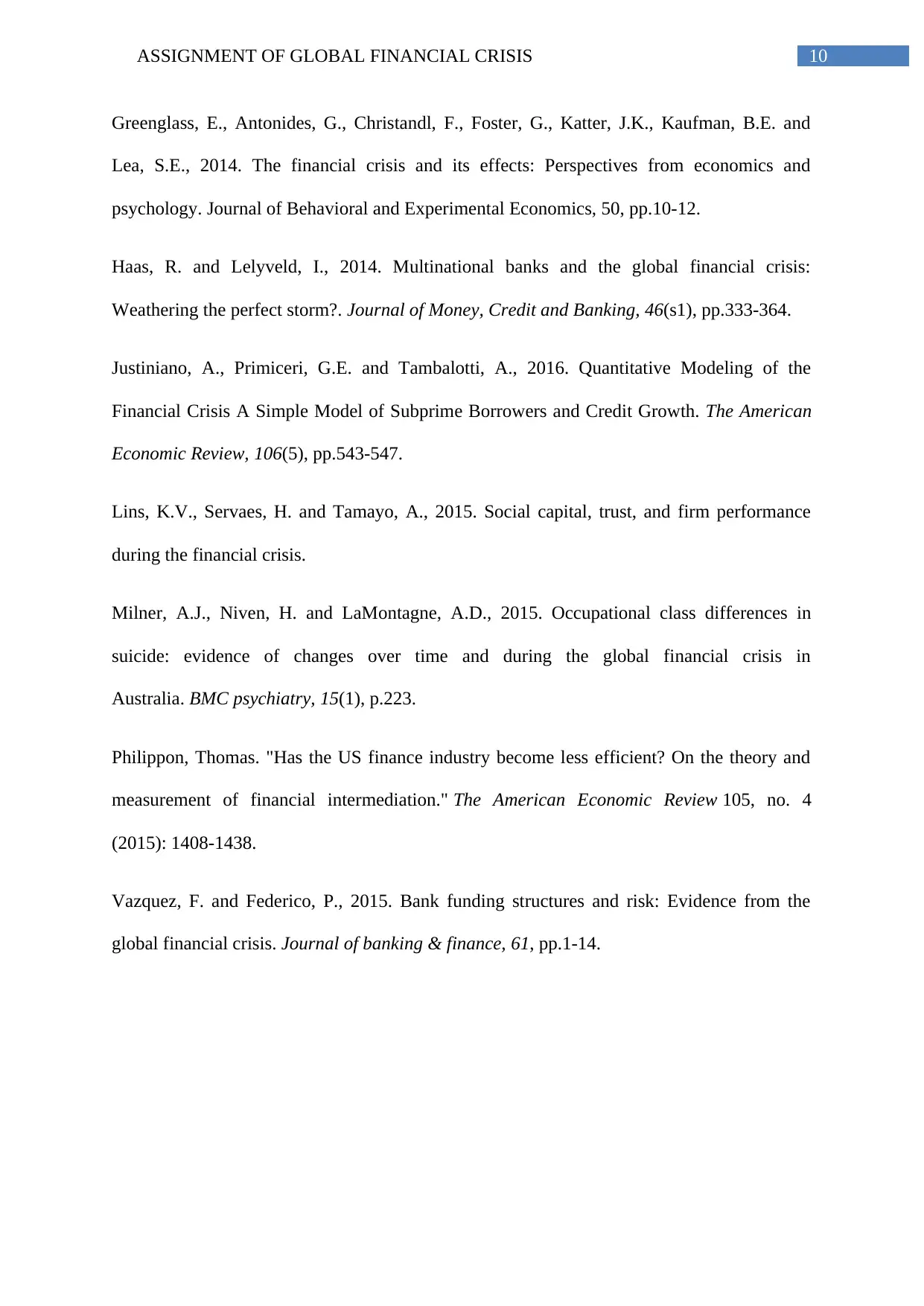
10ASSIGNMENT OF GLOBAL FINANCIAL CRISIS
Greenglass, E., Antonides, G., Christandl, F., Foster, G., Katter, J.K., Kaufman, B.E. and
Lea, S.E., 2014. The financial crisis and its effects: Perspectives from economics and
psychology. Journal of Behavioral and Experimental Economics, 50, pp.10-12.
Haas, R. and Lelyveld, I., 2014. Multinational banks and the global financial crisis:
Weathering the perfect storm?. Journal of Money, Credit and Banking, 46(s1), pp.333-364.
Justiniano, A., Primiceri, G.E. and Tambalotti, A., 2016. Quantitative Modeling of the
Financial Crisis A Simple Model of Subprime Borrowers and Credit Growth. The American
Economic Review, 106(5), pp.543-547.
Lins, K.V., Servaes, H. and Tamayo, A., 2015. Social capital, trust, and firm performance
during the financial crisis.
Milner, A.J., Niven, H. and LaMontagne, A.D., 2015. Occupational class differences in
suicide: evidence of changes over time and during the global financial crisis in
Australia. BMC psychiatry, 15(1), p.223.
Philippon, Thomas. "Has the US finance industry become less efficient? On the theory and
measurement of financial intermediation." The American Economic Review 105, no. 4
(2015): 1408-1438.
Vazquez, F. and Federico, P., 2015. Bank funding structures and risk: Evidence from the
global financial crisis. Journal of banking & finance, 61, pp.1-14.
Greenglass, E., Antonides, G., Christandl, F., Foster, G., Katter, J.K., Kaufman, B.E. and
Lea, S.E., 2014. The financial crisis and its effects: Perspectives from economics and
psychology. Journal of Behavioral and Experimental Economics, 50, pp.10-12.
Haas, R. and Lelyveld, I., 2014. Multinational banks and the global financial crisis:
Weathering the perfect storm?. Journal of Money, Credit and Banking, 46(s1), pp.333-364.
Justiniano, A., Primiceri, G.E. and Tambalotti, A., 2016. Quantitative Modeling of the
Financial Crisis A Simple Model of Subprime Borrowers and Credit Growth. The American
Economic Review, 106(5), pp.543-547.
Lins, K.V., Servaes, H. and Tamayo, A., 2015. Social capital, trust, and firm performance
during the financial crisis.
Milner, A.J., Niven, H. and LaMontagne, A.D., 2015. Occupational class differences in
suicide: evidence of changes over time and during the global financial crisis in
Australia. BMC psychiatry, 15(1), p.223.
Philippon, Thomas. "Has the US finance industry become less efficient? On the theory and
measurement of financial intermediation." The American Economic Review 105, no. 4
(2015): 1408-1438.
Vazquez, F. and Federico, P., 2015. Bank funding structures and risk: Evidence from the
global financial crisis. Journal of banking & finance, 61, pp.1-14.
1 out of 11
Related Documents
Your All-in-One AI-Powered Toolkit for Academic Success.
+13062052269
info@desklib.com
Available 24*7 on WhatsApp / Email
![[object Object]](/_next/static/media/star-bottom.7253800d.svg)
Unlock your academic potential
Copyright © 2020–2025 A2Z Services. All Rights Reserved. Developed and managed by ZUCOL.





